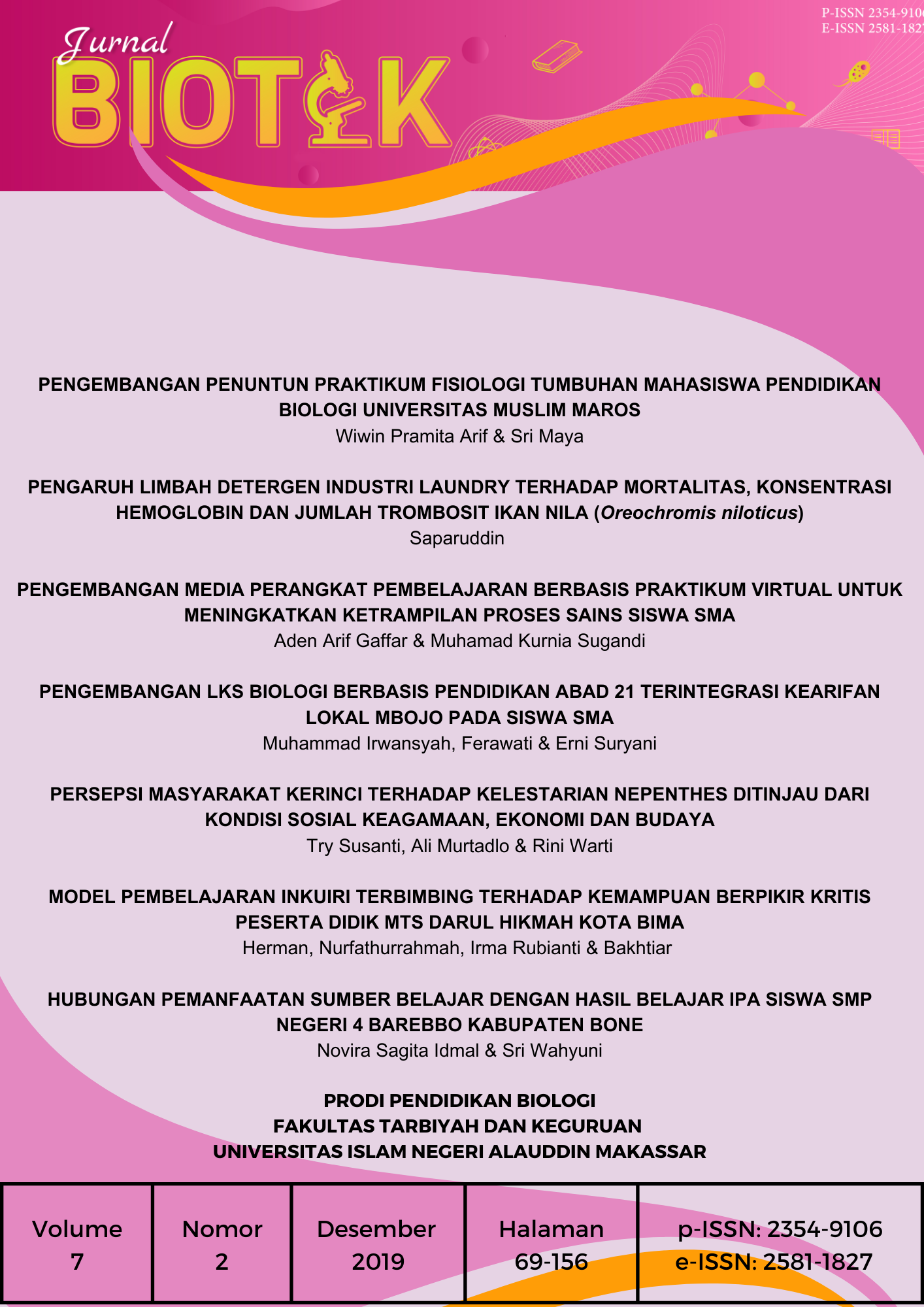PERSEPSI MASYARAKAT KERINCI TERHADAP KELESTARIAN NEPENTHES DITINJAU DARI KONDISI SOSIAL KEAGAMAAN, EKONOMI DAN BUDAYA
Abstract
Kerinci memiliki 4000 spesies flora, didominasi oleh famili dipterocarpaceae, leguminosaceae, lauraceae, myrtaceae dan nepenthaceae. Masyarakat Kerinci umumnya bermata pencaharian sebagai petani. Dalam usaha memenuhi kebutuhan hidup sehari-hari seperti bahan makanan dan obat, masyarakat Kerinci masih tergantung pada tumbuh-tumbuhan yang ada disekitar mereka, baik jenis-jenis tumbuhan yang sengaja ditanam di sekitar pekarangan rumah atau ladang mereka, ataupun jenis-jenis tumbuhan yang masih tumbuh liar di jalan, ladang maupun hutan. Penelitian ini bertujuan untuk mempertelakan secara ilmiah persepsi masyarakat Kerinci terhadap kelestarian nepenthes terkait kondisi sosial keagamaan, ekonomi dan budaya masyarakat setempat. Terkait kondisi sosial keagamaan, hasil penelitian menunjukkan bahwa pemanfaatan nepenthes tidak berhubungan dengan kegiatan-kegiatan keagamaan. Sedangkan secara ekonomi, masyarakat memiliki komitmen yang tinggi untuk menjaga kelestarian nepenthes dan habitatnya, dan tidak memanfaatkannya sebagai komoditas ekonomi untuk diperjualbelikan. Sebaliknya nepenthes sangat berhubungan erat dengan kegiatan adat khususnya upacara adat sko
Downloads
References
Akhiardi, et al (2007). The Natural Hybrids of Nepenthes in Sumatra. Abstract : Serawak Nepenthes Summit, 18 – 21 August 2007. Serawak Forestry, Malaysia.
Akhriadi, P & Hernawati, (2006). A Field Guide to The Nepenthes of Sumatera. First Edition. Published by PILI- NGO Movement and Nepenthes Team. Bogor. Indonesia: xiv + 94 hlm.
Azwar. F, et al (2007). Kantong Semar (Nepenthes Sp.) Di Hutan Sumatera Tanaman Unik Yang Semakin Langka. Prosiding Ekspose Hasil-Hasil Penelitian: 173-181.
Bappeda Kabupaten Kerinci. 2012. Sejarah Kabupaten Kerinci.
Bappenas. (1993). Biodiversity Action Plan for Indonesia. Government of Indonesia. Dalam Bappenas. 2003. Strategi dan rencana aksi keanekaragaman hayati Indonesia 2003 -- 2020. IBSAP Dokumen Regional. Bappenas. Jakarta: xi + 289 hlm
Bauer, U. & W. Federle. (2009). The insect-trapping rim of Nepethes pitchers. Surface Structure and Function. Plant Signaling & Behavior (11): 1019–1023.
Cheek, M. & M. Jebb. (2001). Nepenthaceae. Flora Malesiana. Series I, (2000): 1-157.
Clarke, C. & J. A. Moran. (2011). Incorporating ecological context: a revised protocol for the preservation of Nepenthes pitcher plant specimens (Nepenthaceae). Blumea (56): 225–228.
Clarke, C. (2001). Nepenthes of Sumatra and Peninsular Malaysia. Natural History Publications, Kota Kinabalu: x + 326 hlm.
Departemen Kehutanan, 2003. Kumpulan Peraturan Perundang-Undangan Bidang Kehutanan dan Konservasi. Balai Konservasi Sumer Daya Alam Sumatera Barat.
Djufri. (2002). Penentuan Pola Distribusi, Asosiasi, dan Interaksi Spesies Tumbuhan Khususnya Padang Rumput di Taman Nasional Baluran, Jawa Timur. Jurnal Biodiversitas (1) 181-188.
Guthiga, P.M. (2008). Understanding local communities’ perceptions of existing forest management regimes of A Kenyan Rainforest. International Journal of Social Forestry (2): 145-166.
Irawanto, R. (2009). Pemanfaatan Tumbuhan Nepenthes oleh Masyarakat Desa Bagak Singkawang. Kalimantan Barat. Prosiding seminar Nasional Etnobotani IV. Cibinong Science Center. LIPI: 313-318.
Mansur, M. (2002). Nepenthes gymnamphora Nees. di Taman Nasional Gunung Halimun dan penyebarannya di Indonesia. Berita biologi (1): 107—114.
Mansur, M. 2006. Nepenthes, Kantong Semar yang Unik. Penebar Swadaya, Jakarta: 99 hlm
Mansur, M. (2007). Keanekaragaman Jenis Nepenthes (kantong semar) Daratan Rendah di Borneo Tengah. Berita Biologi (50): 335-339.
Mansur, M. (2008). Penelitian Ekologi Nepenthes di Laboratorium Alam Hutan gambut Sabangau Kereng Bangkirai Kalimantan Tengah. Jurnal Teknologi Lingkungan (1): 67-73.
Mardhiana dkk. (2012). Karakteristik dan Kelimpahan Nepenthes di Habitat Miskin Unsur Hara. Jurnal Lahan Suboptimal (1): 50-56.
Merbach, M.A, et al. (2007). Why a Carnivorous Plant Cooperates with an Ant—Selective Defense Against Pitcherdestroying Weevils in The Myrmecophytic Pitcher Plant Nepenthes Bicalcarata Hook. f. Ecotropica : 45-56.
Nepenthes Team, (2004). A Conservation Expedition Of Nepenthes In Sumatera Island. Final Report For BP Conservation Programme. Padang Indonesia.
Puspitaningtyas, D.M & H. Wawangningrum. (2007). Keanekaragaman Nepenthes di Suaka Alam Selasih Talang Sumatera Barat. Biodiversitas (2): 152-156.
Robinson, A.S, et al. (2009). A Spectacular New Species of Nepenthes L. (Nepenthaceae) Pitcher Plant from Central Palawan, Philippines. B.J Linnean Society. (159): 195 - 202.
Sari, R. (2009). Keanekaragaman Jenis Kantung Semar (Nepenthes spp) dan Pemanfaatannya Bagi Masyarakat Lokal. Prosiding seminar Nasional Etnobotani IV. Cibinong Science Center. LIPI: 308-312.
Singh, B. et al. (2011). Conservation Strategies for Nepenthes khasiana in The Nokrek Biosphere Reserve of Garo Hills, Northeast, India. Journal of Cconservation Science 2. (1): 55-64.
Walujo, E.B. (2009). Etnobotani: Memfasilitasi penghayatan, pemutakhiran pengetahuan dan kearifan lokal dengan menggunakan prinsip-prinsip dasar ilmu pengetahuan. Dalam Purwanto, Y. & E.B. Waluyo (eds.). 2009. Keanekaragaman hayati, budaya dan ilmu pengetahuan. Prosiding Seminar Nasional Etnobotani IV. LIPI Press, Jakarta: 12-20.
Witarto, A.B. (2003). Studi Biologi Molekular Tanaman Kantung Semar Menuju Pemanfaatannya untuk Molekular Farming. Puslit Bioteknologi LIPI, Cibinong : 5-13.
Witarto, A.B. (2006). Protein Pencerna di Kantong Semar. Lembaga Ilmu Pengetahuan Indonesia.
Yuliati, S. J.Supriatna, M.A. Rifai & E.B. Walujo. (2009). “Lat batat Kayee batee” Orientasi Nilai Budaya Dan Konservasi Sumberdaya Hayati di Pulau Simeuleu Nanggroe Aceh Darussalam. Prosiding Seminar Etnobotani IV. Cibinong Science Center-LIPI: 96-102.
Copyright (c) 2019 Try Susanti

This work is licensed under a Creative Commons Attribution-ShareAlike 4.0 International License.
Authors who publish with Jurnal Biotek agree to the following terms: Authors retain the copyright and grant Universitas Islam Negeri Alauddin Makassar right of first publication with the work simultaneously licensed under a Creative Commons Attribution License (CC BY-SA 4.0) that allows others to share (copy and redistribute the material in any medium or format) and adapt (remix, transform, and build upon the material) the work for any purpose, even commercially with an acknowledgement of the work's authorship and initial publication in Universitas Islam Negeri Alauddin Makassar. Authors are able to enter into separate, additional contractual arrangements for the non-exclusive distribution of the journal's published version of the work (e.g., post it to an institutional repository or publish it in a book), with an acknowledgement of its initial publication in Universitas Islam Negeri Alauddin Makassar. Authors are permitted and encouraged to post their work online (e.g., in institutional repositories or on their website) prior to and during the submission process, as it can lead to productive exchanges, as well as earlier and greater citation of published work (See The Effect of Open Access).

This work is licensed under a Creative Commons Attribution-ShareAlike 4.0 International License.



